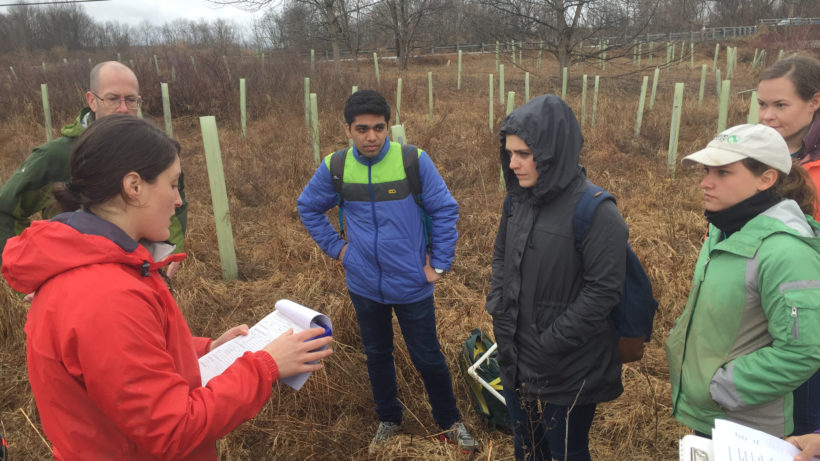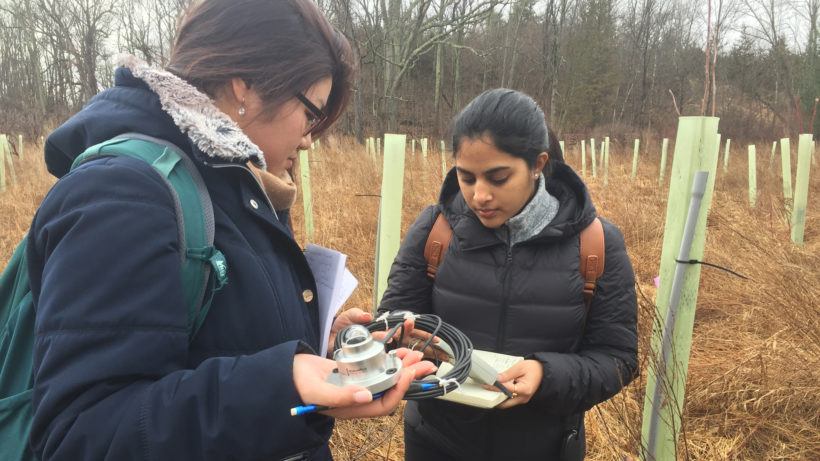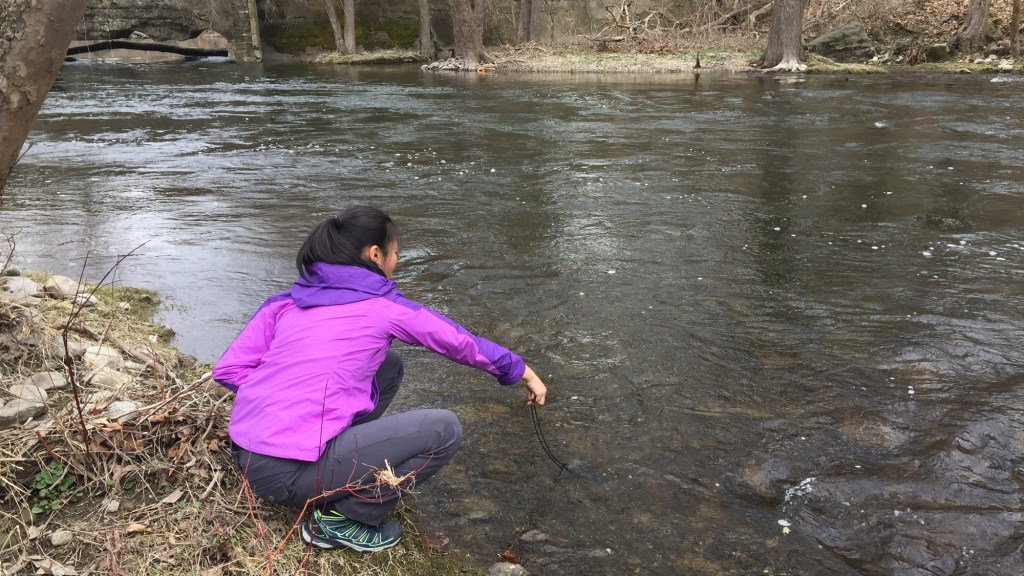On a drizzly, cold Friday at the end of March, I joined a group of fellow Columbia University students and high-tailed it out of New York City in a little red Zipcar named Fred. We were on a mission—the Columbia University Aquanauts were about to kick off a new project with The Nature Conservancy (TNC)! The focus was of this project was to learn about and help monitor the restoration of the Paulins Kill river—a tributary of the Delaware River whose health has declined due to human activity in Warren and Sussex Counties, New Jersey—through a citizen science partnership.
TNC and the Northeast Association of Fish and Wildlife Agencies identified the Columbia Dam as a high-priority dam for removal, ranking it in the top 5 percent of dams to be removed in the northeast. But the project doesn’t start with dam removal. TNC has laid out a blueprint for the Paulins Kill restoration, including a few areas in which the Aquanauts are chipping in to help.
The Aquanauts is a student group connected with the Columbia Water Center with a mission to engage water problems globally. I became an Aquanaut to combat nature deficit disorder—the loss of connection people increasingly feel with the natural world—while learning as much as I could about addressing global water challenges. As a student in the Sustainability Management (SUMA) program in Columbia University’s School of Professional Studies, I’m always looking for opportunities to apply what I learn in class to real-world problems. And, as my dad always said, “A bad day fishing is better than a good day at the office.” Well, in our case it was more like, “A rainy day in the floodplain is better than stepping into a surprise three-foot-deep puddle at the corner of Broadway and 114th Street.”

Either Way, We Were Going to Get Our Feet Wet
During our road trip from NYC to the Paulins Kill, and between translating Google Maps directions and handfuls of road trip snacks, the Aquanauts reflected on our mission and how it connected us to the Paulins Kill. About a month before, we’d met with Steve Lyon, a freshwater scientist from TNC New Jersey who would be our spirit guide to the Paulins Kill. Steve told us about the history of the region with a focus on the Columbia Dam and its effects on the surrounding landscape. Constructed in the early 1900s by the Jersey Central Power and Light Company, the dam created a pond for ice harvesting along with energy to light the towns of Columbia, NJ and Stroudsburg, PA. Unfortunately, it also created an 18-foot high barrier for fish, like the American shad, that used to swim up the Paulins Kill to spawn.
Steve highlighted that while the Paulins Kill is in relatively good condition ecologically, there are significant stretches where water temperatures are too warm for aquatic animals due to several impoundments and floodplain deforestation. TNC and partners aim to create a more suitable habitat for wildlife while cultivating space for locals to enjoy the nature that lives in their own backyards. These positive experiences with nature foster conservation-minded individuals.

Aquanauts Take Action in the Field
When we arrived at our first field site, Steve and other members of TNC’s New Jersey Chapter were there to greet us. Decked out in waders and carrying everything from a pyranometer to fluorescent-colored flags, our squad sure looked the part. Once we plodded through the soggy floodplain to our study site, Michelle DiBlasio, Watershed Restoration Coordinator in charge of the floodplain reforestation effort, guided us through our first task: monitoring the health of some of the 35,000 trees TNC planted in the floodplain in previous years. These trees are part of TNC NJ’s goal (and Michelle’s passion) of 100,000 trees planted in the floodplains of NJ by 2020.
We began by cordoning off a circular plot marking our survey boundaries with the fluorescent flags. Any tree saplings that fell within these bounds were our study subjects, and any that fell outside were not to be included. Then we took incoming solar radiation measurements (with that handy dandy pyranometer) to assess how much shade these young trees were providing. The measurements done using the fancy pyranometer were complemented with measurements made using an app we downloaded on our phones a la citizen science. The readings will serve as baseline readings because, while cute, the tree saplings planted in the floodplain were not yet tall enough to provide any significant shade for cooling.
Next, we assessed the current conditions of our plot and general tree survivability: What type of soil was there? What species of groundcover plants could be found? Again, this data served to establish a baseline for the plot, knowing that conditions will change as the trees mature. Speaking of the trees, how had they fared in their first year? Unfortunately, we found a few saplings that hadn’t made it through the winter. Despite being safely ensconced in tubing and held upright by a PVC pipe, some of the trees did not take root in their new environment. Others, though, were flourishing. We started by identifying the species and then got to work logging (ha!) the tree’s height, diameter, and signs of life.

After surveying all the trees in our plot, we headed to our second study site where we could access the main river above the Columbia dam impoundment to get some water quality readings. At that river section and at a second location below the dam impoundment, we measured temperature and electrical conductivity in the stream as proxies for water quality. Satisfied that we’d gotten the reading and that no one had fallen in the water, we got back in the car. These initial measurements of temperature and electrical conductivity will be expanded upon in future Aquanaut visits to the field to assess the impact of the Columbia Dam on the river. That future effort complements TNC’s ongoing monitoring program and emphasizes the need for the dam’s removal, which is slated for summer 2018.
TNC is using select restoration areas as educational demonstration sites for local communities to drive home the importance of restoring and protecting their “hometown” waterway. The Aquanauts are helping to test and perfect procedures for data gathering that can be continued by locals to monitor the health of floodplain trees, water quality, and other signs of progress. This long-term “citizen science” will ensure Paulins Kill is staying healthy after the bulk of the restoration work is done.
Before we parted ways, Steve made sure the Aquanauts had all the equipment we needed to continue our monitoring. We planned to come back a few times in the coming months, perhaps even to witness the dam removal. The actual removal process is apparently a lot less showy than one would expect, but the impacts will be resounding. Restoring the natural river habitat will result in a domino effect of benefits both for wildlife and for people. TNC has found a way to maintain the energy output produced in the area by working with the NJ Division of Fish & Wildlife to install solar panels over the nearby state trout hatchery. The panels will not only generate clean energy, but serve to protect young trout from a bacterial disease spread by ospreys dropping into the hatchery to hunt.
Of course, we couldn’t leave without a few group selfies!!






I’m curious about how the electrical conductivity of the Paulinskill river is measured.